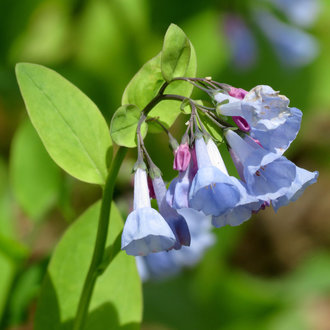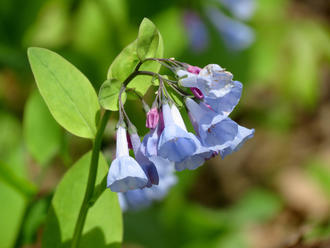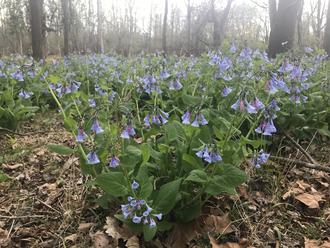Virginia Bluebells (Mertensia virginica (L.) Pers. ex Link)
Also known as Virginia cowslip, lungwort oysterleaf, Roanoke bells.
↑Summary
A spring ephemeral native to eastern North America, found in moist deciduous woodlands, especially floodplains.
↑Range - Expand
| Legend | Color |
| Native | |
| Native or Not Present | |
| Native or Introduced | |
| Native or Introduced or Not Present | |
| Introduced | |
| Native or Expanded |
This tentative map is based on our own research. It may have limited data on Canada and/or Mexico, and there is some subjectivity in our assignment of plants as introduced vs. expanded. Read more in this blog post.
Although this plant occurs somewhere in each of these regions, it may only occur in a small part of some or all of them.
↑Description & Identification
A perennial plant, only present in spring to early summer and dormant the rest of the year. Grows 1-2½ feet tall. Basal leaves are largest, up to 8 inches long and 5 inches wide, and upper leaves on the stem are reduced in size. Leaves are ovate, smooth. Entire plant often has a pale green to slightly bluish or purplish color to the foliage. Stems usually curve at the top, leading to a flower cluster that hangs downward, hence the resemblance to "bells".
Flower buds may cycle through pink and lavender shades, but flowers are usually pale blue at maturity. Rarely plants may be found with white flowers.
Foliage turns yellowish as it dies down.
Root system consists of a deep taproot with spreading rhizomes; roots are fleshy, somewhat fragile, and easily broken or injured.
↑Habitat
Found in moist, rich deciduous woodlands in shaded to partly-shaded sites. Plants are often most dominant in somewhat open woodlands in floodplains and other bottomland areas, but in the heart of its range it can also be found on more mesic, upland sites as well. Usually found in well-drained soils rich in organic matter but can tolerate some other soil types.
At the southernmost limit of this species range in Alabama, it is mostly limited to floodplain forests underlain by limestone. At the northern limit of its range, in New York state, it is also limited to floodplains and bottomlands.
↑Life Cycle
Virginia bluebells is a long-lived perennial spring ephemeral.
Each year, foliage emerges early, before trees leaf out, and usually completely dies down by mid summer. The plant remains dormant during times of hot temperatures and higher competition for light.
Plants usually begin blooming in their second or third year. Plants flower in spring, with flowers lasting about three weeks. Flowers are not self-fertile.
Plants spread both by seed and vegetatively, by rhizomes. Both methods of reproduction are common and important.
↑Faunal Associations
The flowers are visited by a wide range of pollinators, commonly bumblebees and butterflies, but also other long-tongued bees including honeybees, Anthophorid (digger) bees, and mason bees, as well as skippers, moths, and sometimes hummingbirds.
The foliage is occasionally browsed in small quanitites by white-tailed deer, but is mostly avoided by mammalian herbivores. We were not able to find any records of insect herbivores that eat this plant, only one erroneous record that claimed that the larvae of the moth Gnophaela latipennis (which feeds on other Mertensia species) eats this species, but it does not overlap with this species in range.
↑Uses
Commonly used in gardens, where it is valued for its showy flowers of an unusual color, its bluish-colored foliage, and its tendency to die down. Its use in gardens is limited by its moisture demands, and it is not suitable for drier sites.
Collection of wild plants for sale in nurseries, or directly by gardeners, has threatened some wild populations. However, planting of this plant has also led to its expansion into a few sites in New England northeast of its native range.
↑Related Plants
There are twenty other Mertensia species native to North America; however, only one of them overlaps with this species in range. There is a small area at the far north of this species range where it overlaps with a few isolated southern populations of tall bluebells (Mertensia paniculata), a more boreal species.
More broadly, this species belongs to the Boraginoideae subfamily of the borage (Boraginaceae) family. This grouping contains numerous genera of plants found in the wild in North America, both native and introduced, but most of them are limited to the west.
The most widespread related plants in this plant's range are the introduced corn gromwell (Buglossoides arvensis), the native wild comfrey (Cynoglossum virginianum), the introduced common viper's bugloss (Echium vulgare), the native beggarslice (Hackelia virginiana), forget-me-nots (Myosotis sp.) of which three native and several introduced species widely overlap in range, and gromwells or stoneseeds (Lithospermum sp.) with several native and one introduced species.
One introduced plant, bethlehem lungwort (Pulmonaria saccharata), is widely planted in gardens and has established on the wild in part of this species range. There are also three introduced monkswort (Nonea) species established at a few sites in this species range.
↑Links & External Resources
• Mertensia virginica (Virginia Bluebells) | Illinois Wildflowers (About This Site)
• Mertensia virginica (Virginia Bluebells) | USDA PLANTS Database (About This Site)
• Mertensia virginica | Go Botany (About This Site)
• Mertensia virginica (Virginia Bluebells) | Missouri Botanical Garden Plant Finder (About This Site)
• Mertensia virginica | Biota of North America Project (BONAP) (About This Site)
• Mertensia virginica | NatureServe Explorer (About This Site)
• Mertensia virginica | Missouri Plants (About This Site)
• Virginia Bluebells | Maryland Biodiversity Project (About This Site)
• Mertensia virginica (Virginia Bluebells) | Minnesota Wildflowers (About This Site)
• Mertensia virginica (L.) Pers. ex Link (Virginia Bluebells, Virginia Cowslip) | Digital Atlas of the Virginia Flora (About This Site)






